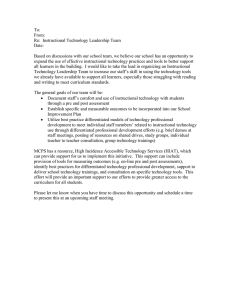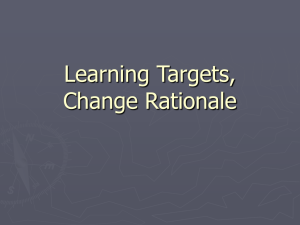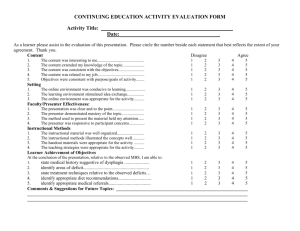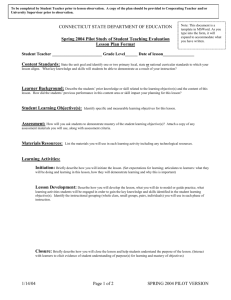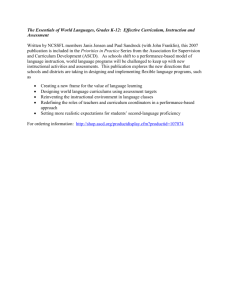Annotated Lesson Plan - West Virginia Wesleyan College
advertisement
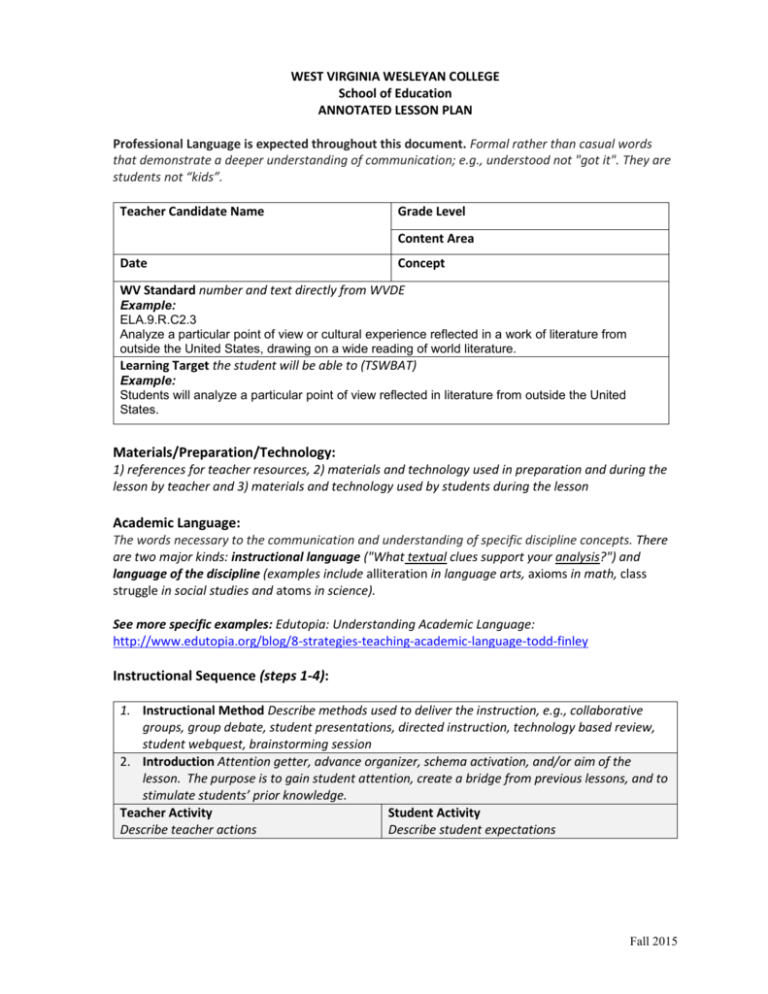
WEST VIRGINIA WESLEYAN COLLEGE School of Education ANNOTATED LESSON PLAN Professional Language is expected throughout this document. Formal rather than casual words that demonstrate a deeper understanding of communication; e.g., understood not "got it". They are students not “kids”. Teacher Candidate Name Grade Level Content Area Date Concept WV Standard number and text directly from WVDE Example: ELA.9.R.C2.3 Analyze a particular point of view or cultural experience reflected in a work of literature from outside the United States, drawing on a wide reading of world literature. Learning Target the student will be able to (TSWBAT) Example: Students will analyze a particular point of view reflected in literature from outside the United States. Materials/Preparation/Technology: 1) references for teacher resources, 2) materials and technology used in preparation and during the lesson by teacher and 3) materials and technology used by students during the lesson Academic Language: The words necessary to the communication and understanding of specific discipline concepts. There are two major kinds: instructional language ("What textual clues support your analysis?") and language of the discipline (examples include alliteration in language arts, axioms in math, class struggle in social studies and atoms in science). See more specific examples: Edutopia: Understanding Academic Language: http://www.edutopia.org/blog/8-strategies-teaching-academic-language-todd-finley Instructional Sequence (steps 1-4): 1. Instructional Method Describe methods used to deliver the instruction, e.g., collaborative groups, group debate, student presentations, directed instruction, technology based review, student webquest, brainstorming session 2. Introduction Attention getter, advance organizer, schema activation, and/or aim of the lesson. The purpose is to gain student attention, create a bridge from previous lessons, and to stimulate students’ prior knowledge. Teacher Activity Student Activity Describe teacher actions Describe student expectations Fall 2015 3. Instruction Describe procedures, subject content, and application. Note instructional methods to be used, major points of the lesson, questions to ask, and how students will practice/perform the concept taught. This is the most detailed part of the plan; consider using numbered steps including time allotted for each. Teacher Activity Student Activity Describe teacher actions Describe student expectations 4. Closure Review, restate, or summarize lesson concepts/objectives. Provide further application (a challenge), reiterate any deadlines, test dates, etc., or discuss problems encountered during the lesson. Teacher Activity Student Activity Describe teacher actions Describe student expectations Differentiated Instruction: SPECIFIC Strategies for Diversity, Individual Differences, Abilities, and Styles List specific individual modifications, adaptations, or accommodations needed for this lesson. See more specific examples: ASCD. Tools for High-Quality Differentiated Instruction. http://differentiation.asb-wiki.wikispaces.net/Home Assessment: Formative: Assessment for learning, to identify what the students know and what needs further reinforcement. Informal evaluation that encourages student practice. Identify the informal or ongoing assessment methods used to determine now the lesson objectives will be evaluated in measurable terms. Refer to the objective, e.g., exit slip, student self-assessment, questioning, ungraded homework, observations. Summative: Formal evaluation of progress and/or performance. Include minimum level of proficiency. Identify the assessment method of content mastery of the instructional objectives, e.g., unit exam, project rubric. Teacher Reflection: How engaged were students? What worked and what is your evidence that it worked? What did students learn and on what evidence are you basing your conclusions? Have ALL students reached mastery of this lesson? Is it necessary to re-teach a concept to some members of the class while others benefit from an exercise that enriches or extends their learning during the unit? What would you do differently and why? Fall 2015
